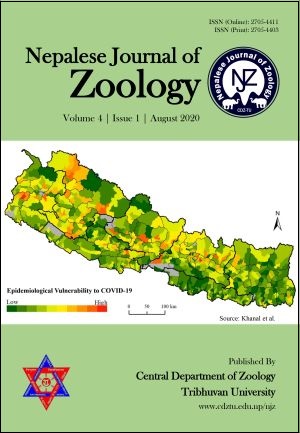Prey quantity affects development, survival and reproductive attributes of Coccinella transversalis Fabricius, 1781 under laboratory conditions
DOI:
https://doi.org/10.3126/njz.v4i1.30668Keywords:
Aphid, Biocontrol, Fecundity, Ladybirds, Prey speciesAbstract
This study assessed development, survival and reproductive parameters of a ladybird beetle, Coccinella transversalis Fabricius, 1781 on different quantities (viz. scarce, optimum and abundant) of the bean aphid prey, Aphis craccivora under laboratory conditions (27 ±1°C; 65 ±5% relative humidity and 14 light: 10 dark hours photoperiod). The pre-oviposition period was the shortest (6.40 ±0.40 days) on abundant prey and longest (9.20±0.49 days) on scarce prey. The oviposition period significantly increased with increasing prey quantity, being longest (55.10 ±1.75 days) on abundant prey and shortest (38.50 ±2.14 days) on scarce prey. Lifetime fecundity and egg viability were recorded the highest (1604.10 ±45.61 eggs and 90.82 ±0.80%, respectively) on abundant diet and lowest (794.60 ±30.84 eggs and 82.72 ±0.67%, respectively) on scarce diet. Reproductive rate, reproductive time ratio, longevity of male and female were all highest, i.e. 29.20 ±0.61 egg/day, 3.70 ±0.26, 65.80 ±1days and 70.30 ±1.30 days, respectively on abundant diet. These parameters were lowest, i.e. 20.90 ±0.83 eggs/day, 1.95 ±0.16, 58.80 ±1.60 days and 56.20 ±1.75 respectively on scarce diet. Development was fastest on abundant prey followed by optimum and slowest on scarce prey. Percentage pupation, percent adult emergence, developmental rate, growth index and generation survival were all highest, i.e. 84.00 ±3.68%, 79.00 ±4.09%, 0.077 ±0.00 day-1, 3.50 ±0.19 day-1, 0.54 ±0.05, respectively when larvae were reared on abundant prey. The same parameters were lowest, i.e. 65.00 ±04.79%, 57.00 ±4.99%, 0.062 ±0.001 day-1, 10.46 ±0.11 day-1, 0.25 ±0.0, respectively on scarce prey. It may therefore be concluded that the availability of abundant prey enhances developmental and reproductive parameters of C. transversalis, and abundant diet of aphid prey may be used for better mass culture of ladybird beetles in laboratories for augmentative biological control of aphids.
Downloads
Downloads
Published
How to Cite
Issue
Section
License
This license enables reusers to distribute, remix, adapt, and build upon the material in any medium or format for noncommercial purposes only, and only so long as attribution is given to the creator.

